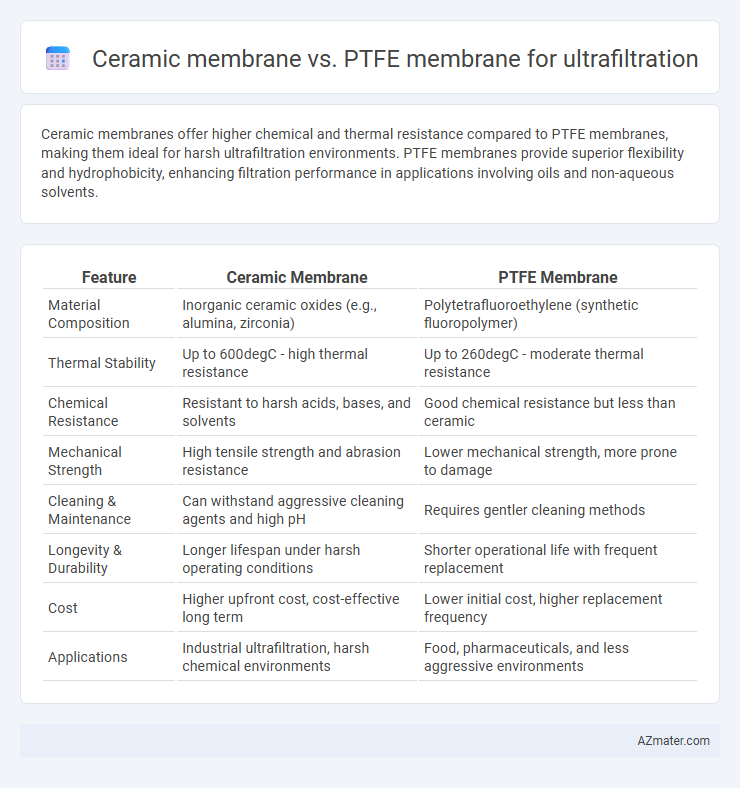Ceramic membranes offer higher chemical and thermal resistance compared to PTFE membranes, making them ideal for harsh ultrafiltration environments. PTFE membranes provide superior flexibility and hydrophobicity, enhancing filtration performance in applications involving oils and non-aqueous solvents.
Table of Comparison
| Feature | Ceramic Membrane | PTFE Membrane |
|---|---|---|
| Material Composition | Inorganic ceramic oxides (e.g., alumina, zirconia) | Polytetrafluoroethylene (synthetic fluoropolymer) |
| Thermal Stability | Up to 600degC - high thermal resistance | Up to 260degC - moderate thermal resistance |
| Chemical Resistance | Resistant to harsh acids, bases, and solvents | Good chemical resistance but less than ceramic |
| Mechanical Strength | High tensile strength and abrasion resistance | Lower mechanical strength, more prone to damage |
| Cleaning & Maintenance | Can withstand aggressive cleaning agents and high pH | Requires gentler cleaning methods |
| Longevity & Durability | Longer lifespan under harsh operating conditions | Shorter operational life with frequent replacement |
| Cost | Higher upfront cost, cost-effective long term | Lower initial cost, higher replacement frequency |
| Applications | Industrial ultrafiltration, harsh chemical environments | Food, pharmaceuticals, and less aggressive environments |
Introduction to Ultrafiltration Membranes
Ultrafiltration membranes, integral to water treatment and biochemical processes, function by selectively separating suspended solids, bacteria, and viruses from liquids. Ceramic membranes exhibit high thermal stability, chemical resistance, and durability, making them ideal for harsh industrial environments. PTFE membranes offer excellent hydrophobicity and are favored for their flexibility and fouling resistance in applications requiring gentle filtration and easy cleaning.
Overview of Ceramic Membranes
Ceramic membranes for ultrafiltration offer exceptional chemical, thermal, and mechanical stability, making them ideal for harsh operating conditions and aggressive media. Their inorganic composition enables higher resistance to fouling and longer lifespan compared to PTFE membranes, which are polymer-based and more prone to physical degradation. Ceramic membranes typically provide superior permeability and selectivity, optimizing separation efficiency in water treatment, food processing, and pharmaceutical applications.
Overview of PTFE Membranes
PTFE membranes offer exceptional chemical resistance and thermal stability, making them ideal for ultrafiltration in aggressive environments. Their hydrophobic nature requires pre-wetting or modification for effective filtration of aqueous solutions. Compared to ceramic membranes, PTFE membranes provide flexibility and lower cost but may have shorter lifespan and lower mechanical strength under high-pressure conditions.
Filtration Performance Comparison
Ceramic membranes exhibit superior filtration performance in ultrafiltration due to their high chemical resistance, thermal stability, and long operational lifespan, enabling efficient removal of particles as small as 0.01 microns. PTFE membranes, while offering excellent hydrophobicity and chemical resistance, generally have lower mechanical strength and shorter service life under harsh conditions compared to ceramic membranes. The higher pore size uniformity and fouling resistance of ceramic membranes result in more consistent permeate flux and better retention of contaminants in ultrafiltration processes.
Chemical and Thermal Resistance
Ceramic membranes exhibit exceptional chemical resistance, withstanding strong acids, alkalis, and solvents, making them suitable for aggressive industrial ultrafiltration processes. PTFE membranes offer high chemical inertness but have lower thermal resistance, typically withstanding temperatures up to 260degC, whereas ceramic membranes endure temperatures above 500degC, enabling operation in extreme thermal environments. The superior thermal and chemical durability of ceramic membranes extends membrane lifespan and reduces maintenance in harsh filtration applications.
Fouling and Cleaning Characteristics
Ceramic membranes exhibit superior fouling resistance compared to PTFE membranes due to their hydrophilic surface, which minimizes organic and biological fouling in ultrafiltration processes. Cleaning ceramic membranes involves aggressive chemical and thermal methods, allowing for repeated regeneration without performance loss, whereas PTFE membranes require gentler cleaning to avoid damage but are more prone to irreversible fouling. The robustness of ceramic membranes translates to longer operational cycles and reduced downtime, making them optimal for challenging feed streams with high fouling potential.
Lifespan and Durability
Ceramic membranes in ultrafiltration exhibit superior lifespan and durability due to their robust inorganic structure, resisting chemical, thermal, and mechanical stresses far better than PTFE membranes. PTFE membranes, while chemically resistant, are more prone to physical damage and degradation under extreme operational conditions, resulting in shorter service life. The enhanced mechanical strength and fouling resistance of ceramic membranes translate to lower replacement frequency and reduced maintenance costs compared to PTFE counterparts.
Cost Analysis and Economic Considerations
Ceramic membranes typically exhibit higher upfront costs compared to PTFE membranes due to their durable inorganic materials and robust fabrication processes. Despite the initial investment, ceramic membranes offer longer lifespan and superior chemical resistance, leading to lower maintenance and replacement expenses over time. Economic considerations favor ceramic membranes for industrial ultrafiltration applications requiring durability, while PTFE membranes might be more cost-effective for short-term or less aggressive filtration environments.
Application Suitability in Various Industries
Ceramic membranes offer exceptional chemical and thermal resistance, making them ideal for harsh industrial applications such as wastewater treatment, food and beverage processing, and pharmaceutical filtration where durability and high temperature tolerance are critical. PTFE membranes provide superior hydrophobicity and chemical inertness, suited for applications involving organic solvents and aggressive chemicals, commonly found in chemical manufacturing and oil and gas industries. The choice between ceramic and PTFE ultrafiltration membranes depends on specific process requirements including temperature, pH levels, and chemical exposure, influencing efficiency and membrane longevity in sectors like wastewater management and chemical processing.
Conclusion: Choosing the Right Ultrafiltration Membrane
Ceramic membranes offer superior chemical resistance, thermal stability, and longer lifespan, making them ideal for harsh industrial ultrafiltration applications. PTFE membranes provide excellent hydrophobicity and flexibility, suitable for applications requiring fine particulate filtration and resistance to fouling. Selecting the right ultrafiltration membrane depends on specific process conditions, including chemical exposure, operating temperature, and maintenance requirements.

Infographic: Ceramic membrane vs PTFE membrane for Ultrafiltration
 azmater.com
azmater.com